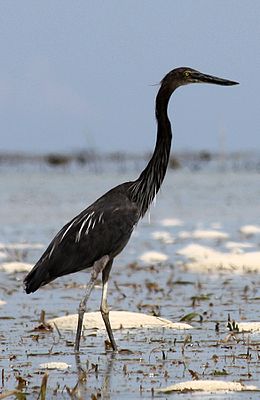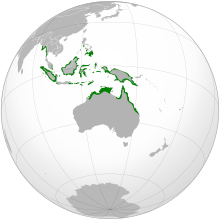Sooty heron
| Sooty heron | ||||||||||||
|---|---|---|---|---|---|---|---|---|---|---|---|---|

Sooty heron ( ardea sumatrana ) |
||||||||||||
| Systematics | ||||||||||||
|
||||||||||||
| Scientific name | ||||||||||||
| Ardea sumatrana | ||||||||||||
| Raffles , 1822 |
The sooty heron ( Ardea sumatrana ) is a species of heron that occurs from South Asia to northern Australia . His sound repertoire is very unusual for herons. The guttural and deep call, especially heard during the night, is reminiscent of the sounds of an excited bull or alligator. In Australia it is therefore also called the Bull-Heron or Alligator-Heron . Other sounds in his repertoire are reminiscent of the running noises of a small engine.
Appearance
The sooty heron is one of the particularly large representatives of the genus Ardea . In large parts of its range, it is the largest species of heron, reaches a body size of 110 to 115 centimeters and weighs between 1,300 and 2,600 grams. There is no gender dimorphism .
Its plumage is predominantly gray-brown. The throat is white to white-gray. At the back of the head, elongated silver-gray feathers form a small tuft. The beak is large and long, black on top and whitish-yellow to greenish on the underside. The iris is yellow to silver brown. The legs are olive colored. It differs from the emperor heron , whose distribution area partially overlaps that of the black heron, by the gray underside of the body. It differs from the gray heron by its size and its gray-brown and not gray plumage, and also by its gray underside.
The flight is slow and cumbersome. The head is put back in the neck. The legs are not drawn up or stretched backwards, but hang down. It rarely flies open and only covers a short distance in flight in the event of a fault. If he feels disturbed, he usually retreats slowly into cover.
Habitat, distribution and existence
The black heron occurs in the coastal area of Burma , Thailand, the Philippines, Borneo , Sulawesi , Sumatra , Java , New Guinea and on the coast of Northern Australia and is predominantly a resident bird. Above all, it is a coastal inhabitant, which can be observed especially in the mangrove swamps. Its habitat is characterized by tall trees near feeding grounds with soft, muddy bottoms that are regularly washed over by water. Inland it is mostly found in forest regions, for example along forest-lined rivers or billabongs . As a rule, it does not occur in open, non-tree-covered regions.
The black heron was once widespread in coastal Asia, but populations have declined sharply over the past fifty years. It is now missing in the coastal areas of Vietnam and Cambodia. It is rare in Papua New Guinea. In Northern Australia, however, it is still a relatively common species and the population is considered stable. The global population size is not precisely known. However, he is considered a habitat specialist who is threatened by changes in his habitat.
Food and foraging
The sooty heron usually searches for food on its own. You can rarely see him in pairs or in small family groups. It is an extremely shy bird that is sensitive to human disturbance. It usually looks for its food in tidal zones; during the high tide it rests. In the breeding season it is mostly active at dusk. As is typical for members of the Ardea genus, it looks for food by wading very slowly through the water, rarely going to depths of more than 30 centimeters. It is not yet certain whether he is defending food territory. One of the threatening gestures towards conspecifics that come too close to him is a conspicuous stilt walk, in which the feather hoods are spread apart and the tail plumage is raised. The diet consists mainly of fish. So far, however, there are no detailed studies of his eating habits. The very powerful beak suggests that crabs and mussels also play a role in its food spectrum.
Reproduction
Very little is known about the breeding biology.
The beginning of the breeding season varies depending on the area of distribution: In Australia clutches are found all year round, in other regions of its distribution area it seems to breed outside of the monsoon season. Basically he breeds alone. Occasionally, however, nests are found close to other birds. The nests are 1.2 to 1.3 meters in diameter and up to 30 centimeters thick. They are built relatively low. The clutches seem to contain only two eggs and usually only one young bird is raised. Up until now, an additional clutch has been observed. It was laid 42 days after the first clutch was destroyed.
supporting documents
literature
- PJ Higgins (Ed.): Handbook of Australian, New Zealand & Antarctic Birds , Volume 1, Ratites to Ducks, Oxford University Press, Oxford 1990, ISBN 0195530683
- James A. Kushlan & James A. Hancock: Herons . Oxford University Press, 2005, ISBN 0198549814
Web links
- Ardea sumatrana inthe IUCN 2013 Red List of Threatened Species . Listed by: BirdLife International, 2012. Retrieved October 16, 2013.
